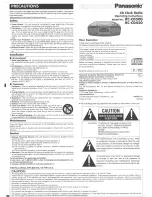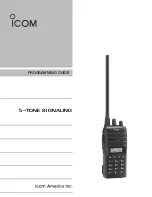
B-1
Appendix B. Distance vs. Antenna
Gain, Terrain, and Other Factors
B.1 Introduction
The communication distance you can expect to obtain using the RF401A series
depends on a number of factors that are unique to every installation. These
unique factors are the path of propagation, relative antenna elevations, and the
link budget.
PATH OF PROPAGATION
Signal loss associated with the path of propagation (path loss) is often the
single, largest factor determining system performance. The reflection,
diffraction, or attenuation of the propagating RF wavefront due to terrain or
man-made obstacles in the path of propagation can significantly reduce the
level of signal reaching the receiver. For optimal performance, one should
make every effort to achieve an unobstructed line-of-sight path between radios.
For an in-depth discussion on the effects of obstructions in the path of
propagation as well as methods for predicting the induced signal loss, refer to
the Campbell Scientific application note
ANTENNA ELEVATIONS
The relative elevation of the transmitting and receiving antennas—to the
surrounding terrain as well as to each other—plays a critical role in
determining the maximum link distance. Greater antenna elevations not only
provide greater obstacle clearance, but also increase the maximum
unobstructed line-of-sight distances over apparently flat terrain. For example,
given 10-foot antenna elevations for both ends of a link and flat, level terrain,
the maximum allowable distance between the antennas before the curvature of
the earth begins to obstruct the RF line of sight is approximately 9 miles.
Increasing the elevation of one or both antennas will increase the maximum
line-of-sight distance.
LINK BUDGET
A link budget is the summation of the systems gains and losses and provides a
means of estimating the signal level arriving at the receiver. By comparing the
signal level reaching the receiver with the signal level required by the receiver
to produce a minimal level of performance, one can estimate the link’s fade
margin. The fade margin—received signal level in excess of the receiver’s
sensitivity—provides a measure of the link’s operational viability. The greater
the fade margin, the greater the potential long-term reliability. A minimally
acceptable fade margin is 10 dB. For optimal system performance and
reliability, it is generally recommended that one should design for a fade
margin of 20-30 dB. For detailed information on calculating a link budget and
Содержание RF401A Series
Страница 2: ......
Страница 4: ......
Страница 6: ......
Страница 8: ......
Страница 12: ...Table of Contents iv ...
Страница 17: ...RF401A Series Spread Spectrum Radio 5 FIGURE 6 1 RF401A series dimensions ...
Страница 40: ......
Страница 50: ...Appendix B Distance vs Antenna Gain Terrain and Other Factors B 10 ...
Страница 51: ......












































